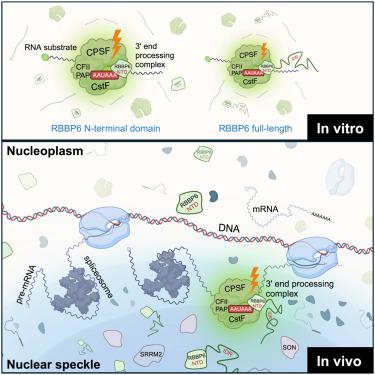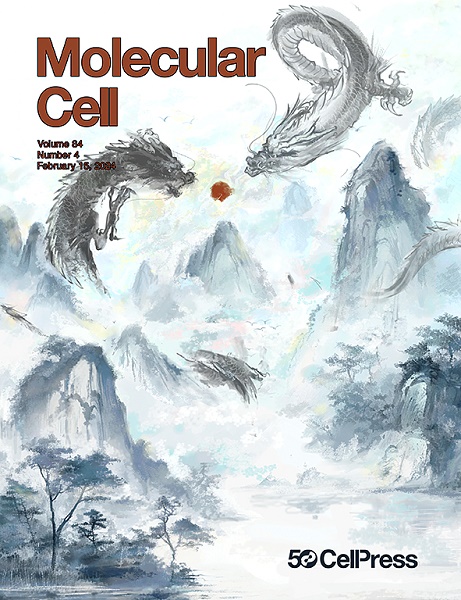RBBP6 anchors pre-mRNA 3′ end processing to nuclear speckles for efficient gene expression
IF 14.5
1区 生物学
Q1 BIOCHEMISTRY & MOLECULAR BIOLOGY
引用次数: 0
Abstract
Pre-mRNA 3′ processing is an integral step in mRNA biogenesis. However, where this process occurs in the nucleus remains unknown. Here, we demonstrate that nuclear speckles (NSs), membraneless organelles enriched with splicing factors, are major sites for pre-mRNA 3′ processing in human cells. We show that the essential pre-mRNA 3′ processing factor retinoblastoma-binding protein 6 (RBBP6) associates strongly with NSs via its C-terminal intrinsically disordered region (IDR). Importantly, although the conserved N-terminal domain (NTD) of RBBP6 is sufficient for pre-mRNA 3′ processing in vitro, its IDR-mediated association with NSs is required for efficient pre-mRNA 3′ processing in cells. Through proximity labeling analyses, we provide evidence that pre-mRNA 3′ processing for over 50% of genes occurs near NSs. We propose that NSs serve as hubs for RNA polymerase II transcription, pre-mRNA splicing, and 3′ processing, thereby enhancing the efficiency and coordination of different gene expression steps.

RBBP6将前mrna 3 '端加工锚定在核斑点上,以实现有效的基因表达
前mRNA 3 '加工是mRNA生物发生的重要步骤。然而,这个过程发生在细胞核的什么地方仍然未知。在这里,我们证明了核斑点(NSs),即富含剪接因子的无膜细胞器,是人类细胞中pre-mRNA 3 '加工的主要位点。研究人员发现,视网膜母细胞瘤结合蛋白6 (RBBP6)通过其c端内在无序区(IDR)与NSs密切相关。重要的是,尽管RBBP6的保守n端结构域(NTD)足以在体外加工pre-mRNA 3 ‘,但idr介导的与NSs的关联是细胞中有效的pre-mRNA 3 ’加工所必需的。通过接近标记分析,我们提供的证据表明,超过50%的基因的前mrna 3 '加工发生在NSs附近。我们认为NSs是RNA聚合酶II转录、前mrna剪接和3 '加工的枢纽,从而提高了不同基因表达步骤的效率和协调性。
本文章由计算机程序翻译,如有差异,请以英文原文为准。
求助全文
约1分钟内获得全文
求助全文
来源期刊

Molecular Cell
生物-生化与分子生物学
CiteScore
26.00
自引率
3.80%
发文量
389
审稿时长
1 months
期刊介绍:
Molecular Cell is a companion to Cell, the leading journal of biology and the highest-impact journal in the world. Launched in December 1997 and published monthly. Molecular Cell is dedicated to publishing cutting-edge research in molecular biology, focusing on fundamental cellular processes. The journal encompasses a wide range of topics, including DNA replication, recombination, and repair; Chromatin biology and genome organization; Transcription; RNA processing and decay; Non-coding RNA function; Translation; Protein folding, modification, and quality control; Signal transduction pathways; Cell cycle and checkpoints; Cell death; Autophagy; Metabolism.
 求助内容:
求助内容: 应助结果提醒方式:
应助结果提醒方式:


